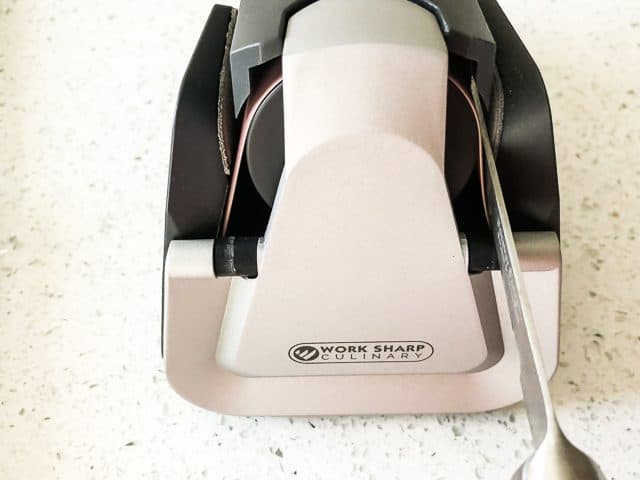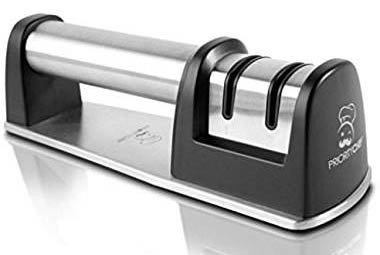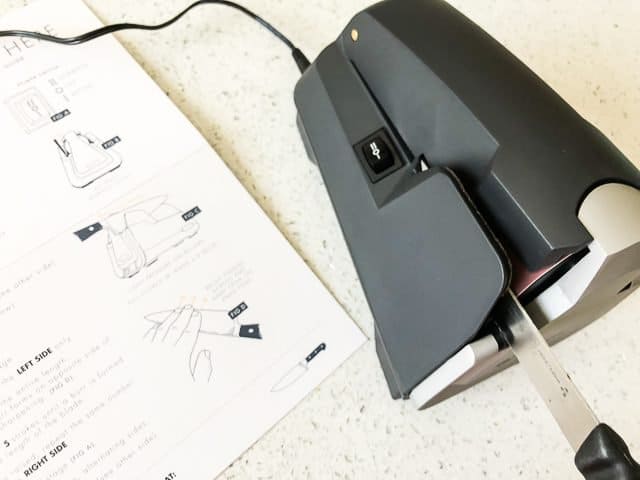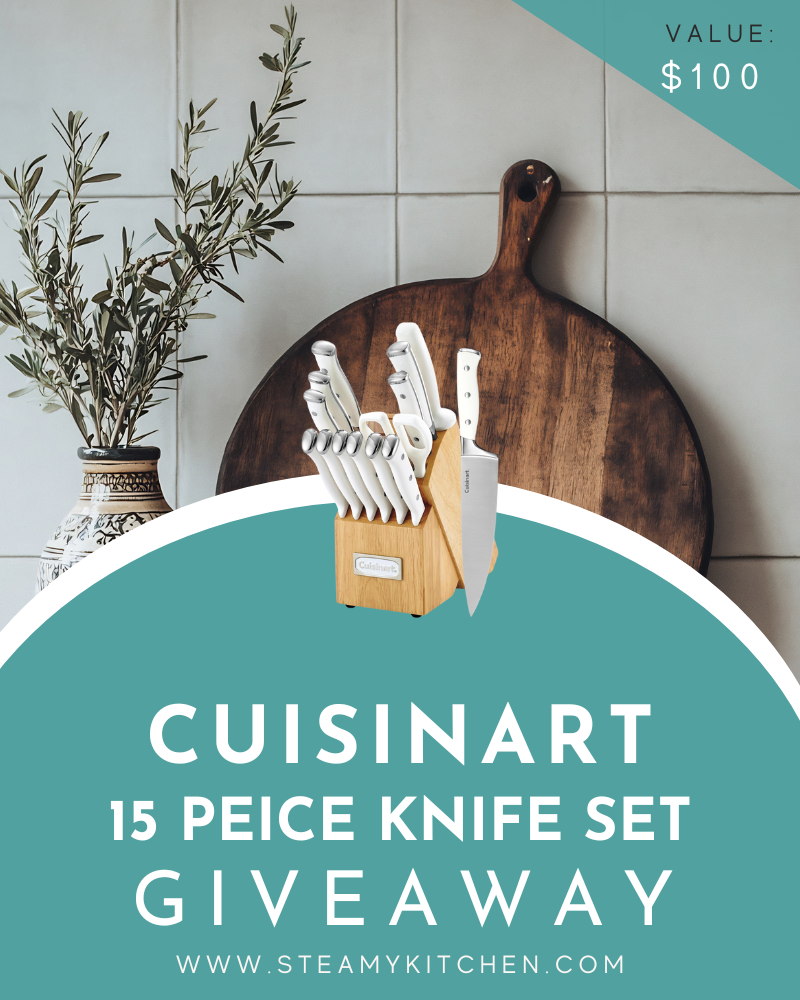This is a Work Sharp Culinary E3 Knife Sharpener Review – we’ll show you both PROs and CONs of this electric knife sharpener.
Work Sharp Culinary E3 Review
We’ve tested dozens of knife sharpeners, electric, manual, and even Japanese whetstones. In the past, we’ve recommended the Chef’s Choice electric sharpener with both 15° and 20º angles to sharpen both Japanese and European knives….as well as Japanese whetstones for the obsessive cook.
After using the Work Sharp Culinary E3, I’ve changed my mind about the ideal knife angle for Western knives. But first, a little about why knife edge angles are important.
Why are there different knife angles?
One of the factors that determine knife sharpness and durability is edge angle, or bevel. The steeper the bevel, the sharper the knife. However, the thinner edges are more prone to chipping and breaking.
Traditionally, Europeans knives have a thicker 20º angle, and Japanese knives have a sharper 15º angle. This is directly related to cooking styles of the past. Much of Japanese/Asian cooking involves vegetables, seafood and meats sliced thinly.
Asian style of cooking favors thinner blade edge
Sharp, thinner blades make it easier to cut ingredients into smaller pieces for stir fries, sushi, etc. Meats are generally sliced thinly, and eaten in moderation, with the bones saved for making soup. For example, Vietnamese Pho (thinly sliced meat in broth), Thai beef salad (thinly sliced vegetables and meats), Chinese stir-fries, Japanese yakitori.
Thinner blade edge requires harder steel material for the blade. That means the 15º sharp edge will be retained longer, but the harder steel/razor thin edge also means the blade can chip and shatter easily. My Japanese Global chef’s knife and Shun chef’s knife both have chips on the blade
For butchery or heavy chopping, Asian cooks will generally use a thick, heavy meat cleaver.
European/Western style of cooking
In Western kitchens, cooks preparing big roasts, whole chickens, steaks, root vegetables need stronger knives. The 20º angle edge with a thicker, heavier blade can hack though a pork roast. However, the wider angle also means it’s harder to keep that sharp edge.
The best of both worlds
We used the E3 to re-shape one of my American-made New West KnifeWorks slicing knife to a 17º angle.
Work Sharp Culinary E3: What’s in the box

From left to right: User’s Guide, honing handle, ceramic honing rod, power adapter, sharpener.
Open up the sharpener, and you’ll find a belt system.
The belt feels like heavy duty sandpaper (it’s a continuous loop). I actually like this system better than other electric (and non-electric) sharpeners – I’ll tell you why in a bit.
You’ll also find extra belts in the back. The sharpening belt easily pops off.
Sharpening with Work Sharp Culinary E3
I only have the one New West KnifeWorks knife that had a 20º edge, and I didn’t want to re-shape any of my Asian style knives. Since I ran out of knives to sharpen for photos. I instructed my brother to bring me any old knives he wanted sharpened.
He brought me old knives that he’s had since college (uh, that was like 15 years ago.) But actually, it was a great test. Can the E3 sharpen old, cheap knives so well it could rival my beloved $300 chef’s knife?
This is an old Wüsthof knife. It’s dull.
I followed the instructions and swiped the blade on both sides.
And a few swipes on the ceramic honing rod.
Paper test….WOW. Sliced so cleanly through a single sheet of paper.

Tried another cheap knife. This silver knife doesn’t even have a name on the blade. I think he got it in a set for free from opening a bank account somewhere.

This knife took a little more work on each side. Will it cut through even thinner magazine paper?
Yeaaaah, but see that little hitch near the top? Knife needs a few more swipes in the sharpener.

And now it’s RAZOR sharp. Cuts right though flimsy magazine paper (which is harder to do than regular white copy paper).

Why I like sharpening belts better than….
…better than any other sharpening option.
9 out of 10 of my friends have one of these in their kitchen drawer:

I used to recommend these to people who were on a budget….until I looked at a knife blade with a magnifying glass. The edges were jagged, uneven. The knives felt “sharp” because the jagged edges sawed through ingredients, not because the edge was polished and sharp. These cheap manual sharpeners will make your knives cut better, but will ruin your good knives. This type of sharpener is basically 2 pieces of thin metal, angled together to a “V” so that when you run your knives through the slots, the blade will rub against the “V” and “sharpen.” But in reality, it takes away steel from your blade unevenly and harshly.
This type of electric sharpener…

…has a metal wheel embedded with “diamonds” that grinds away the steel from your blade. It’s more even than the above manual sharpener, but grinding metal on metal is still harsh, and it takes away too much of the blade material. That’s why you can never get a razor sharp, polished edge with these machines.
The Work Sharp Culinary E3 belt system is gentler on the blade, and sharpens very well.
Here are the cons of the Work Sharp Culinary E3 Knife Sharpener
- It takes longer to sharpen than other electric knife sharpeners – mainly because it sharpens with the belt vs. metal wheel.
- Over time, the belts will need to be replaced. Included with the E3 are 3 belts total. Replacements are inexpensive, $10 for a set of 3.
- The E3 only contains 1 type of abrasive belt (Work Sharp Culinary has 4 different types of belts, each with different abrasiveness, so that you can get a fine polish on your blade). The belt included is a Red P120 Medium belt.
You can purchase this Work Sharp Culinary E3 Knife Sharpener on Amazon for $135.00.
In the next couple of weeks, I’ll be reviewing the Work Sharp Culinary E5 model, which includes both 15º and 20º edge options, so if you have both Asian style and Western style knives, wait for the E5 review.


































































0 Comments